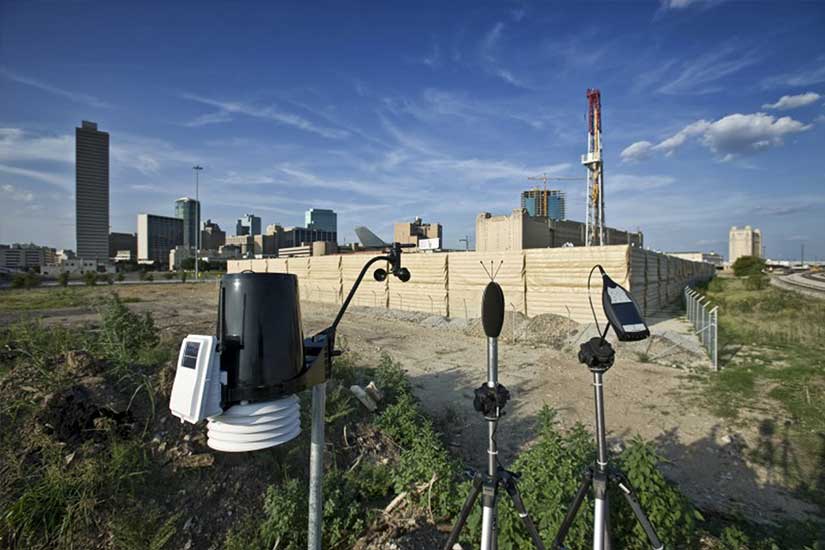
Noise Control
Noise Survey & Control
AHigh levels of occupational noise exposure can lead to physical damage such as permanent hearing loss, psychological stress, reduction in productivity, communication interference, lost concentration, and workplace accidents and injuries. The National Institute for Occupational Safety and Health (NIOSH) reports that, each year, approximately 22 million US workers are exposed to hazardous noise levels at work.
What is a Workplace Noise Survey?
A workplace noise survey involves measuring noise levels throughout a facility using calibrated instruments to identify areas, equipment, or tasks that produce elevated noise levels. Information gathered during noise survey testing can be used to develop a noise survey mapping of high-risk locations that can be used to develop and implement noise controls. As an element of the workplace noise survey, is a work day time weighted average (TWA) noise exposure that leads to a permissible exposure level (PEL) for an individual employee measured using both area and personal noise dosimeter placed directly on a worker. Individual workplace noise monitoring can provide employee exposure levels needed for comparison to guidance from regulatory OSHA hearing conservation threshold and from non-regulatory sources in industry.
Gathering both area source and individual noise exposure levels can provide valuable information on sustained or intermittent loud noise for addressing employee health risks including permanent hearing loss, psychological stress, and workplace accidents and injuries as well as organizational concerns including compliance, reduction in productivity, and workers compensation and/or legal action.
Hearing Conservation Program Employees with noise exposures equal to or exceeding the Action Level (AL) at 85 dBA 8-hr TWA must be included in a Hearing Conservation Program (HCP). An OSHA HCP is designed to protect workers with occupational noise exposure from hearing impairment. The elements of a HCP include: Monitoring employee noise exposures. Implementing feasible engineering, administrative and work practice controls. Providing each overexposed employee with individually fitted hearing protection with an adequate noise reduction rating (NRR). Training employees on noise hazards and protection measures. Measuring employee baseline and annual audiometry (measurement of range and sensitivity of an individual’s hearing). If identified, implementing procedures for preventing further occupational hearing loss by an employee. Keeping records such as exposure measurements and audiometric test results. RHP’s noise monitoring services can assist with 29 CFR 1910.95 or 29 CFR 1926.52 compliance or assistance with fulfilling elements of a HCP including workplace noise monitoring or noise control.
Hazardous Noise and Risks of Hearing Loss in the Workplace Noise is often defined as unwanted sound. When sound is too loud, either by an intense one-time impulse sound or continuous exposure over an extended period of time, it can lead to noise induced hearing loss (NIHL). Hearing loss can also be caused by exposure to chemicals which are harmful to the ear (ototoxic). These chemicals include solvents, heavy metals, and asphyxiates. Occupational noise or ototoxic exposure hearing loss is among the most common workplace injuries. A worker’s susceptibility to noise may vary due to biological factors including age, gender, race/ethnicity, and genetics. Due to individual variability, employers may look to offer genetic or medical testing for worker accommodation. Preventing hearing loss is important. Work-related hearing loss is permanent and can greatly impact quality of life and effectiveness of your work force. To prevent hearing loss, NIOSH recommends determining whether the noise within the workplace is hazardous, reducing hazardous noise exposure, and reducing or controlling chemical exposure risks that my damage hearing. RHP provides effective solutions to reduce employee noise or chemical exposures and that aid in meeting OSHA compliance. In addition to occupational noise, environmental noise complaints can be very contentious and problematic. RHP CIHs have experience in tackling environmental noise issues including performing octave band analysis to determine compliance with State and Federal regulations, and in addressing local community leaders and regulators. RHP can provide real solutions that are defendable and effective.
Noise Monitoring Services We Provide RHP conducts noise monitoring utilizing sophisticated equipment such as integrated sound level meters and dosimeters. Sound level meters are instruments which measure frequency weighted and time averaged sound pressure levels as well as unweighted peaks and impulse noise levels. Noise dosimeters are specialized, and often shoulder mounted, sound level meters which measure individual noise exposure over time. The instruments are regularly calibrated to insure accurate measurements.
RHP’s experienced and trained professionals using integrated sound level meters and noise dosimeters provides noise monitoring services:
- Preliminary survey of building configuration and identification of employee similar exposure groups (SEGs) to develop a noise assessment strategy.
- Sound level mapping or octave band analysis using an integrated sound level meter to identify areas, equipment, or processes that are producing elevated noise levels and group noises with similar properties.
- Individual employee noise monitoring using personal noise dosimeters to measure individual time weighted average (TWA) employee noise exposure, permissible exposure levels (PEL) and percent allowable dose levels for comparison to non-regulatory guidance from NIOSH and the American Conference of Governmental Industrial Hygienists (ACGIH) as well as the regulatory OSHA hearing conservation threshold
PPE recommendations based on the manufacturer noise reduction rating (NRR) for particular applications and sourcing. Our Occupational Noise Solutions Following an employee and facility noise assessment survey, RHP professionals prepare detailed reporting and sound level mapping to show area, task and individual exposure levels as they relate to the OSHA regulatory AL/PEL as well as to industry averages and guidance. The noise survey mapping pinpoints areas, equipment, and process of concern to assist with implementation of noise controls.
- Low-noise tools
- Noise reduction
- Reduce vibration
- Isolate
- Barrier
- Ear protection
- Noise source
- Eliminating noise
- Controlling noise



